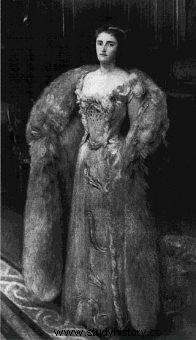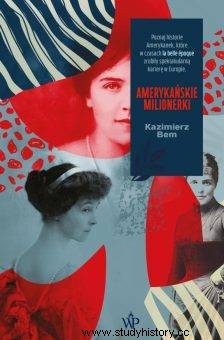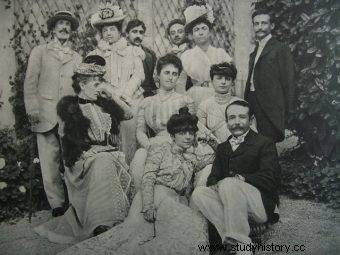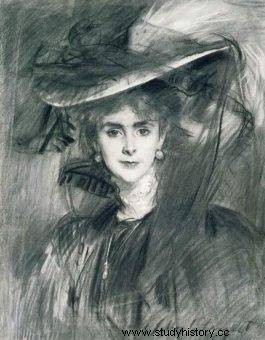She was born heiress to the Singers' fortune - her father was the famous inventor of the sewing machine. She tied her life with Paris, where she ran a music and art salon, was socially active and provided the press and society of that time with constant reasons for rumors. She had two unconsummated marriages behind her and many romances, but only with women. What was Winnaretta Singer-Polignac really like?
Childhood (not necessarily) from a fairy tale
The father, who gave her a name that was as fanciful as it was fascinating, and who exerted a tremendous influence on his daughter (conveyed her passion for art and literature), died when she was only 10 years old. Later in life, Winnarett, who treated her father devoutly and developed an almost cult around him, told friends that her name came from the indigenous peoples of North America, who in her time were called "red-skinned" or "Indians" . More likely, however, Isaac simply invented them, as did the names of his other children from other relationships, which he had a total of 24. Winnaretta's mother was the beautiful and vain Isabella Eugénie Boyer, three decades younger than Isaac, who found herself in a wedding rug. being heavily pregnant with their first son, Adam Mortimer. As we read in American millionaires Kazimierz Bem:
"In June 1863, Singer and Boyer at his New York residence were married by an Anglican pastor. Singer rewarded him handsomely not only for the marriage ceremony but also for the fact that the pastor never registered him with the local registry office, making him legally invalid. Singer liked both to seduce and to deceive the mothers of his children. ”
Another child of the Singers was Winnaretta Eugénie, born on January 8, 1865. Even though Isaac had turned fifty and was starting to suffer from various ailments, including rheumatism, only a few months after Winnie was born, Isabella was expecting a baby again. She had a miscarriage in June, but was pregnant again in September. Washington's son was born in 1866, followed by another in 1867 - Paris, two years later daughter Isabelle-Blanche, and in 1870 the couple's last son - Franklin.
Five years after his birth, Issac died, leaving twenty children - begotten over four decades (actually 24, but four died earlier) - two wills, the subject of judicial disputes between his offspring and more or less legal wives or lovers, and a fabulous fortune of greatness 14 million then, and more than 320 million today dollars. Isabella was judged by the court to be Isaac's only legal widow. Winnaretta received 1.5 million inheritance (currently over 35 million), and her money was to be managed by her mother until she reached the age of majority .
Mournful notes on a teenager's birthday
Winnaretta was devastated by her father's death, and her bitterness was further aggravated by the fact that her mother did not intend to remain a widow for too long. A few years after her husband's death, she married Victor Reubsaet, a penniless musician from a poor artisan family who claimed to be an aristocrat. In 1881, by various means, he managed to obtain the title of Duke of Camposelice from the Italian king, which suited the vain Isabella extremely well. She immediately purchased an estate in Paris, which she turned into a villa, vibrant with social and artistic life. The 36-year-old Duchess, still of delightful beauty, shone in the company as she always wanted.

Winnaretta in 1889
Winnaretta hated her stepfather, and she barely tolerated her mother, but with reciprocity - Isabella was disappointed in her vanity that the older daughter did not inherit (unlike her younger sister) her beauty from her mother. The girl's relations with her grandmother, especially Aunt Jane, were much better. However, one thing cannot be denied to Isabella:she had a perfect ear and a wonderful voice, and her love of music was - apart from her strong character - the only remarkable trait that Winnaretta acquired after her. My daughter willingly took part in weekly concerts, where she listened to the quartets of Mozart, Schubert and Beethoven . The biographers of the future Duchess de Polignac agree that music was for the young Winnaretta a way of expressing suppressed emotions and feelings and a form of escape from conflicts in the family.
She was a girl closed in on herself, somewhat distanced from her surroundings, with a melancholy and romantic disposition. Behind the façade of shyness and seriousness there was an unwavering will and a strong personality. She knew from an early age what she wanted in life and pursued her goals with relentless determination . She received a thorough education that belonged to virgins from her sphere:painting and playing the piano were among her favorite activities. From a self-portrait painted by a twenty-something-year-old Winnaretta, a serious young woman in a colorful coat and curlers looks ahead with melancholy eyes, holding an open book, and in the background, behind a window covered with red flowers, you can see a green garden. However, it was music that was and would remain her greatest love. When asked by her mother what she would like for her 14th birthday, Winnaretta replied without hesitation that she would like to listen to the String Quartet No. 14 in C minor, Op. 131 Beethoven - the same that Schubert wished to hear on his deathbed on November 19, 1828.
Almost half a century after their inception, Beethoven's late string quartets still remained incomprehensible to most audiences - except for the most sensitive and sophisticated music lovers, Winnie among them. It is worth spending less than 40 minutes listening to this work and trying to imagine the emotions and reactions of the guests who, on the winter evening of 1879, gathered in the Parisian salon of Winnaretta's mother and stepfather to celebrate her birthday. Wagner once wrote that the first movement of the quartet "reveals the most melancholic moods expressed in music" and in fact, the ethereal, mournful sounds of the opening fugue put the listener in a strange state where sadness and elation are mixed.

The text was created, among others based on the book by Kazimierz Bem "American Millions", which has just been published by Wydawnictwo Poznańskie.
On the threshold of adulthood, Winnaretta's life was dominated by sadness, loneliness and misunderstanding. She had a bad relationship with her stepfather - there were rumors that the impetuous Victor abused and even raped the girl, and that her mother would be on her side, she could not count . For both of them, her money mattered more than the girl's well-being - especially since Prince Camposelice had an extremely lavish lifestyle and almost squandered his wife's fabulous fortune. Eventually, on the threshold of adulthood, with the agreement of her father's lawyers, Winnaretta gained independence, obtained her rights and money, and left home at the age of 21 to begin really living.
Marriages - white or lavender
In one of the biographies of the future Duchess de Polignac we read the following description from her youth:
"The gray-blue eyes looked at the world stubbornly and firmly, and the incredibly straight nose and slightly protruding chin gave the face an almost male aggression."
Winnaretta Singer, heiress to my father's fortune, though not one of the greatest beauties of her time, was certainly the perfect match. Unfortunately, these times were difficult for women because they were forced into a rigid corset of social rules and expectations. Until they got married, they had limited opportunities to participate in social life. The mother made sure that the Singing family was integrated with the Parisian elite, so the daughter should not have remained in the shadows, and could only leave it as a sedate wife . The decision to get married, though necessary, was extremely difficult for Winnaretta, and the candidate had to be selected with the greatest care, as the future bride did not intend to share a bed with him. Moreover, in order to circumvent the inhumane provisions of the Napoleonic Code, according to which the wife's property passed entirely to her husband, Winnaretta reasonably assigned her fortune to a trust fund to be administered by her brothers residing in England. On July 28, 1887, Winnaretta was married to Count Ludwik Wilfred de Scey-Montbeliard, who came from an old, poor noble family from Burgundy. He obtained a high level of life, she - a name and title, social position and the required facade of decency and respect. Their wedding night was either highly unconventional or, more likely, nonexistent. As Kazimierz Bem writes:
"Years later, a legend was told that during her wedding night, Winnaretta stood on the bed with a knife and threatened Ludwik to kill him if he touched her. But this anecdote to explain Winnaretta's first marriage in terms of her sexual orientation arose many, many years later. The truth is perhaps more prosaic:the marriage to de Scey-Montbeliard was her first attempt at a white marriage with a gay. As it turned out, unsuccessful. After their relationship broke up, Ludwik never married or got into a relationship with another woman. "

Winnaretta (center of the second row) with husband Edmond de Polignac (standing left) and friends
The bone of contention between the spouses, rather than the life itself, were financial matters that the young people apparently had not agreed upon among themselves. Citing the reason - and how - the lack of consummation of the relationship, Winnaretta at the end of 1889 filed for a civil divorce and church annulment of the marriage . In the spring of 1892 she was free again, but being divorced was frowned upon in Parisian society, and not consummating a marriage exacerbated rumors of homosexuality. Luckily, an ideal candidate stood in her way - Prince Edmond Melchior Jean Marie de Polignac, poor as a church mouse, though perfectly educated and socially well-mannered, an old bachelor, grandson of the famous Marie Antoinette favorite, Yolanda Gabriela de Polignac.
According to the account of Marcel Proust, who later often visited the princes de Polignac, Winnaretta and Edmond met during an auction where they fought for the painting of Monet Champs de tulipes en Hollande. She won, and the prince, though furious at first about the defeat, joked later:"I married this American woman so that I could look at the painting as often as I wanted."
"You're an aunt yourself!"
Duke de Polignac was the so-called a black sheep in the family:against the wishes of his relatives, he decided to become a composer, so he and his future wife shared a passion for music, but not only. He was also gay, which was his undoubted advantage. Both Winnaretta, under thirty, and Edmond, almost sixty-year-old, entered into a marriage with open eyes and clear expectations, which certainly contributed to the fact that the relationship lasted and turned out to be successful . The spouses were united by a deep bond, undoubtedly sincere affection, mutual respect and understanding, as well as common interests, although virulent critics did not refrain from commenting that she took him for her surname and he took her for money, or that the lyre stood on a wedding carpet with a machine sewing. In American millionaires we read:
"The spouses genuinely liked each other and the one gave the other what they needed:her, in addition to her name, Edmond twice her age gave a sense of stability, fulfilled the role of a father for whom all her life she missed and stimulated her intellectually and culturally. Winnaretta, for her part, finally gave him the financial and emotional stability he desired, which allowed him to create and compose in the last decade of his life, and her intelligence and sophistication made him revive and flourish creatively and intellectually. They dealt with their sexual needs with due discretion. They were the perfect example that a marriage can be fulfilled and happy without a procreative function. ”
The Duchess was obviously hot-blooded because she did not shy away from romances, and the press and gossipers had use. She got involved in shorter and longer relationships both during her marriages and later, after the death of her second husband, and chose both single and married women as lovers. Apparently, one of the offended husbands appeared in front of the Duchess' Venetian residence and shouted that if she is even half the man he thinks she is, he will accept the challenge to a duel. Her lovers included model and writer Olga de Meyer, painter Romaine Brooks, composer Ethel Smyth, pianist Renata Borgatti, writer Violet Trefusis, garden designer Alvilde Chaplin, who later married James Lees-Milny, and writer Virginia Woolf. / strong>

Model and writer Olga de Meyer
was one of her loversIn the interwar period, the Duchess de Polignac was called "Winnie" by her closest friends, although many did not dare to be so familiar with the seemingly distant and seemingly cool lady. There was an anecdote about how, during the ball, Baron Robert de Rothschild, otherwise famous for his fiery temperament, called across the room, "Good evening, Aunt Winnie," and in response he heard as much virulent as it was ambiguous:"You are an aunt yourself!" laughter room.
Art, music and philanthropy
However, it was not fortune or even romances that made Winnaretta the celebrity of her time, but artistic and social activity. In 1894, the princely couple opened a music and art salon in their Parisian palace located on today's Georges-Mandela Avenue, where social life flourished. After her husband's death, the Duchess continued her patronage over art, science and literature, sparing her enormous fortune, which she managed so efficiently that, despite her lavish life, she did not have to complain about scarcity .
She had social contacts with Ignacy Paderewski, Wanda Landowska or Artur and Nelly Rubinstein, young Maurice Ravel dedicated his Pawana to the death of the Infanta to the Duchess. and many composers, such as Igor Stravinsky, Erik Satie, Darius Milhaud, Francis Poulenc, Jean Francaix, Kurt Weill and Germain Teilleferre, could count on her support and protection. Marcel Proust, Isadora Duncan, Jean Cocteau, Claude Monet, Colette and Sergei Diagilew - the creator of Les Ballets Russes, whom she helped financially many times - were regular guests at the Duchess's salon. The famous conductor Arturo Toscanini, after concerts at the Polignac Palace, went to the kitchen to help prepare spaghetti for dinner for the numerous guests. His daughter married the pianist Vladimir Horowitz, who stayed with the Dukes of Polignac for several years, befriending the Duchess. She never abandoned her second love, namely painting, and her canvases, sometimes mistaken for works by Manet himself, were exhibited at the Académie des Beaux-Arts.

The text was created, among others based on the book by Kazimierz Bem "American Millions", which has just been published by Wydawnictwo Poznańskie.
Winnaretta Singer-Polignac was not limited to artistic patronage, but also engaged in social activities. Acting in cooperation with the French Salvation Army, on its behalf, the rebellious architect Le Corbusier rebuilt or built several buildings in the 1920s and 1930s for shelters for the homeless and battered and abandoned mothers with children . Even during World War I, the Duchess joined efforts with Marie Curie in converting private cars obtained from the French aristocracy into mobile x-ray laboratories, which were sent to the front to help wounded soldiers.
After the war, she supported the construction of the Hôpital Foch in the suburbs of Paris - today this facility is one of the best in France, specializing in, among others, in kidney transplants. The Singer-Polignac Foundation, established by the Duchess in 1928, which promotes and supports art and culture as well as philanthropic activities, is still operating. . Concerts and recitals still draw crowds to the Parisian palace of the Dukes of Polignac, continuing the artistic legacy of Winnaretta, who died on November 26, 1943 in London, then bombed by the Germans. On the first anniversary of her death in "Le Figaro" it was written that it was impossible to create a chronicle of the 20th century without taking into account the heritage of de Polignac and the importance of her salon on Avenue Henri-Martin and the Venetian palace on the Grand Canal for the culture and art of the era.
The author argued that the Duchess should deserve merit as one of the most distinguished patrons of the arts in history . She was certainly also an extraordinary person, an inherent but also rebellious child of her era.
The text was created, among others based on the book by Kazimierz Bem "American Millions", which has just been published by Wydawnictwo Poznańskie.
